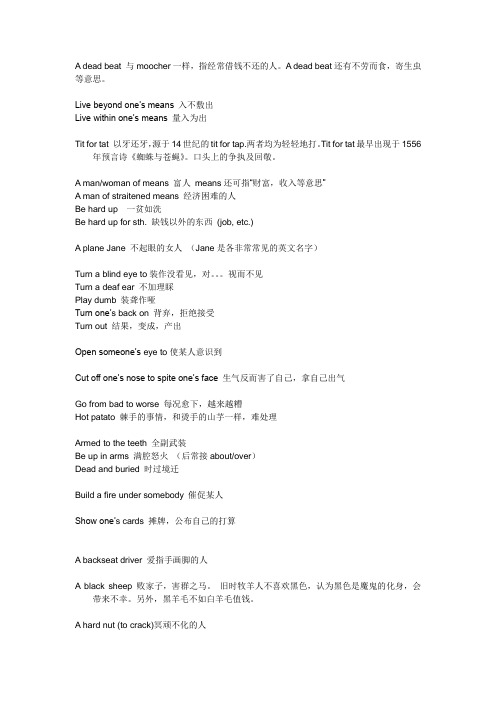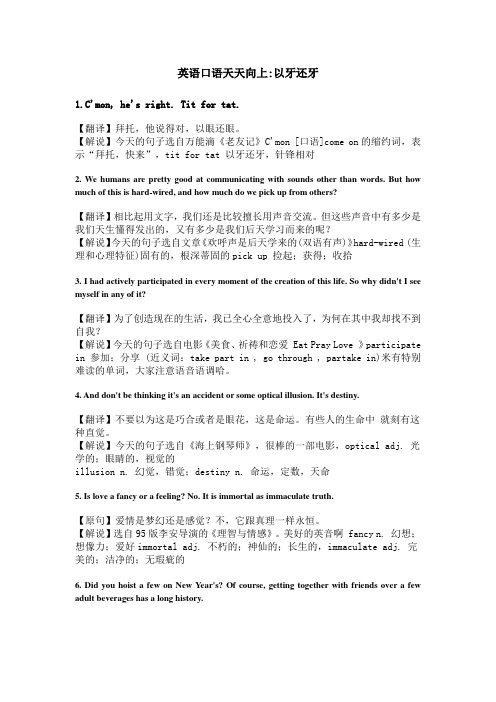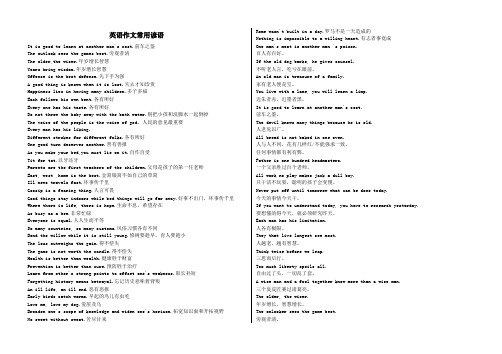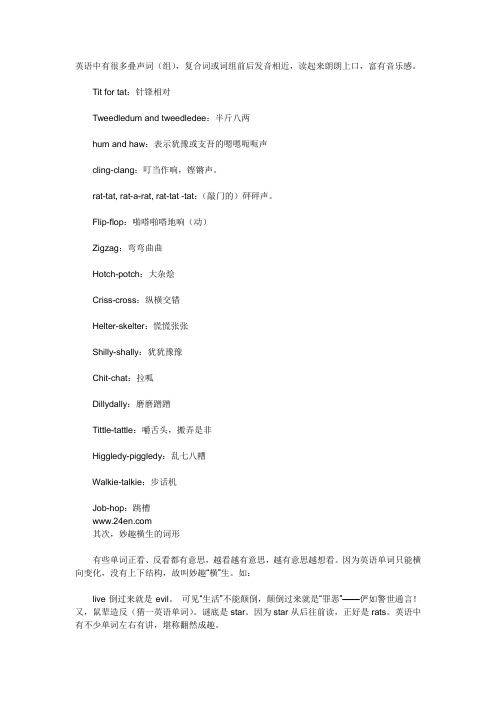Tit for tat
- 格式:doc
- 大小:31.50 KB
- 文档页数:4

A dead beat 与moocher一样,指经常借钱不还的人。
A dead beat还有不劳而食,寄生虫等意思。
Live beyond one’s means 入不敷出Live within one’s means 量入为出Tit for tat 以牙还牙,源于14世纪的tit for tap.两者均为轻轻地打。
Tit for tat最早出现于1556年预言诗《蜘蛛与苍蝇》。
口头上的争执及回敬。
A man/woman of means 富人means还可指“财富,收入等意思”A man of straitened means 经济困难的人Be hard up 一贫如洗Be hard up for sth. 缺钱以外的东西(job, etc.)A plane Jane 不起眼的女人(Jane是各非常常见的英文名字)Turn a blind eye to装作没看见,对。
视而不见Turn a deaf ear 不加理睬Play dumb 装聋作哑Turn one’s back on 背弃,拒绝接受Turn out 结果,变成,产出Open someone’s eye to使某人意识到Cut off one’s nose to spite one’s face 生气反而害了自己,拿自己出气Go from bad to worse 每况愈下,越来越糟Hot patato 棘手的事情,和烫手的山芋一样,难处理Armed to the teeth 全副武装Be up in arms 满腔怒火(后常接about/over)Dead and buried 时过境迁Build a fire under somebody 催促某人Show one’s cards 摊牌,公布自己的打算A backseat driver 爱指手画脚的人A black sheep 败家子,害群之马。
旧时牧羊人不喜欢黑色,认为黑色是魔鬼的化身,会带来不幸。

英语口语天天向上:以牙还牙1.C'mon, he's right. Tit for tat.【翻译】拜托,他说得对,以眼还眼。
【解说】今天的句子选自万能滴《老友记》C'mon [口语]come on的缩约词,表示“拜托,快来”,tit for tat 以牙还牙,针锋相对2. We humans are pretty good at communicating with sounds other than words. But how much of this is hard-wired, and how much do we pick up from others?【翻译】相比起用文字,我们还是比较擅长用声音交流。
但这些声音中有多少是我们天生懂得发出的,又有多少是我们后天学习而来的呢?【解说】今天的句子选自文章《欢呼声是后天学来的(双语有声)》hard-wired (生理和心理特征)固有的,根深蒂固的pick up 捡起;获得;收拾3. I had actively participated in every moment of the creation of this life. So why didn't I see myself in any of it?【翻译】为了创造现在的生活,我已全心全意地投入了,为何在其中我却找不到自我?【解说】今天的句子选自电影《美食、祈祷和恋爱 Eat Pray Love 》participate in 参加;分享 (近义词:take part in , go through , partake in)米有特别难读的单词,大家注意语音语调哈。
4. And don't be thinking it's an accident or some optical illusion. It's destiny.【翻译】不要以为这是巧合或者是眼花,这是命运。

英语作文常用谚语It is good to learn at another man's cost.前车之鉴The outlook sees the games best.旁观者清The older,the wiser.年岁增长智慧Years bring wisdom.年岁增长智慧Offence is the best defense.先下手为强A good thing is known when it is lost.失去才知珍贵Happiness lies in having many children.多子多福Each follows his own bent.各有所好Every one has his taste.各有所好Do not throw the baby away with the bath water.别把小孩和洗脚水一起倒掉The voice of the people is the voice of god。
人民的意见最重要Every man has his liking.Different strokes for different folks.各有所好One good turn deserves another.善有善报As you make your bed,you must lie on it.自作自受Tit for tat.以牙还牙Parents are the first teachers of the children.父母是孩子的第一任老师East, west ,home is the best.金窝银窝不如自己的草窝Ill news travels fast.坏事传千里Gossip is a fearing thing.人言可畏Good things stay indoors while bed things will go far away.好事不出门,坏事传千里Where there is life, there is hope.生命不息,希望存在As busy as a bee.非常忙碌Everyone is equal.人人生而平等So many countries, so many customs.风俗习惯各有不同Bend the willow while it is still young.修树要趁早,育人要趁小The loss outweighs the gain.得不偿失The game is not worth the candle.得不偿失Health is better than wealth.健康胜于财富Prevention is better than cure.预防胜于治疗Learn from other's strong points to offset one's weakness.取长补短Forgetting history means betrayal.忘记历史意味着背叛An ill life, an ill end.恶有恶报Early birds catch worms.早起的鸟儿有虫吃Love me, love my dog.爱屋及乌Broaden one's scope of knowledge and widen one's horizon.拓宽知识面和开拓视野No sweet without sweat.苦尽甘来Rome wasn't built in a day.罗马不是一天造成的Nothing is impossible to a willing heart.有志者事竟成One man's meat is another man 's poison.百人有百好。

妙趣横生的发音英语中有很多叠声词(组),复合词或词组前后发音相近,读起来朗朗上口,富有音乐感。
Tit for tat:针锋相对Tweedledum and tweedledee:半斤八两hum and haw:表示犹豫或支吾的嗯嗯呃呃声cling-clang:叮当作响,铿锵声。
rat-tat, rat-a-rat, rat-tat -tat:(敲门的)砰砰声。
Flip-flop:啪嗒啪嗒地响(动)Zigzag:弯弯曲曲Hotch-potch:大杂烩Criss-cross:纵横交错Helter-skelter:慌慌张张Shilly-shally:犹犹豫豫Chit-chat:拉呱Dillydally:磨磨蹭蹭Tittle-tattle:嚼舌头,搬弄是非Higgledy-piggledy:乱七八糟Walkie-talkie:步话机Job-hop:跳槽∙∙3楼妙趣横生的词形有些单词正看、反看都有意思,越看越有意思,越有意思越想看。
因为英语单词只能横向变化,没有上下结构,故叫妙趣“横”生。
如:live倒过来就是evil。
可见“生活”不能颠倒,颠倒过来就是“罪恶”——俨如警世通言!又,鼠辈造反(猜词)。
谜底是sta r。
因为s tar从后往前读,正好是r ats。
英语中有不少单词左右有讲,堪称翻然成趣。
Are--------- era(时代);bin (贮藏器)----- nib(笔尖);bu t ------ tu b (盆);deer(鹿)----- reed (芦苇); d oor----- r ood(十字架);doom (注定)----- moo d(心情);de em(认为)----- meed报答); d ot(点)----- tod (狐);evil(罪恶)------ live(生活);G od----- do g;gnat (小烦扰)----- tang(强烈的味道);gu lp(吞)-------plu g(插座);gu t(内容,实质)----- tug(猛拉,苦干);ke el(船的龙骨)------leek (韭葱);lo op(环)----- pool (水池);lo ot(赃物)-----eet---- tee m(充满,涌现);ni p(呷)------ pin (大头针);no d(点头)------ don(大学教师);no t----- ton (吨);on---- n o;pan (平底锅)------- nap (小睡);pa rt----- tra p(陷阱);pe ts(宠物)------- step;p ots (壶)-----stop;p ut-----tup (公羊);ra il(铁轨)------ liar(说ram(公羊)------ mar(弄糟);ra w(生的)------ war;sa w(锯)----- wa s;sloop (小型护航舰)-----pools;smart (机灵的)----- trams (电车);sn ap(猛咬,争购)----- pans;ta p(水龙头)------ pat(轻拍);te n----- net (网);tog(衣服)------ got;to m(雄猫)----- mot(警句);to ps(顶)t(点);tun(大酒桶)------ nut(坚果)。

英语中有很多叠声词(组),复合词或词组前后发音相近,读起来朗朗上口,富有音乐感。
Tit for tat:针锋相对Tweedledum and tweedledee:半斤八两hum and haw:表示犹豫或支吾的嗯嗯呃呃声cling-clang:叮当作响,铿锵声。
rat-tat, rat-a-rat, rat-tat -tat:(敲门的)砰砰声。
Flip-flop:啪嗒啪嗒地响(动)Zigzag:弯弯曲曲Hotch-potch:大杂烩Criss-cross:纵横交错Helter-skelter:慌慌张张Shilly-shally:犹犹豫豫Chit-chat:拉呱Dillydally:磨磨蹭蹭Tittle-tattle:嚼舌头,搬弄是非Higgledy-piggledy:乱七八糟Walkie-talkie:步话机Job-hop:跳槽其次,妙趣横生的词形有些单词正看、反看都有意思,越看越有意思,越有意思越想看。
因为英语单词只能横向变化,没有上下结构,故叫妙趣“横”生。
如:live倒过来就是evil。
可见“生活”不能颠倒,颠倒过来就是“罪恶”——俨如警世通言!又,鼠辈造反(猜一英语单词)。
谜底是star。
因为star从后往前读,正好是rats。
英语中有不少单词左右有讲,堪称翻然成趣。
Are--------- era(时代);bin(贮藏器)----- nib(笔尖);but ------ tub(盆);deer(鹿)----- reed(芦苇);door----- rood(十字架);doom(注定)----- mood(心情);deem(认为)----- meed(适当的报答);dot(点)----- tod(狐);evil(罪恶)------ live(生活);God----- dog;gnat(小烦扰)----- tang(强烈的味道);gulp(吞)-------plug(插座);gut(内容,实质)----- tug(猛拉,苦干);keel(船的龙骨)------leek(韭葱);loop(环)----- pool (水池);loot(赃物)----- tool,meet---- teem(充满,涌现);nip(呷)------ pin(大头针);nod(点头)------ don(大学教师);not----- ton(吨);on---- no;pan(平底锅)------- nap(小睡);part----- trap(陷阱);pets(宠物)------- step;pots(壶)-----stop;put-----tup (公羊);rail(铁轨)------ liar(说谎者);ram(公羊)------ mar(弄糟);raw(生的)------ war;saw(锯)----- was;sloop(小型护航舰)-----pools;smart(机灵的)----- trams(电车);snap(猛咬,争购)----- pans;tap(水龙头)------ pat(轻拍);ten----- net(网);tog(衣服)------ got;tom(雄猫)----- mot(警句);tops(顶)------- spot(点);tun(大酒桶)------ nut(坚果)。

英语四级作文常用名言和谚语Value and a trade are the best portion for children.德行和技能是孩子最好的遗产。
Better early than late. 宁早勿迟。
A man can do no more than he can. 量力而行。
Honesty and diligence should be your eternal mates. 诚实和勤奋应成为你永远的伴侣。
Early birds catch the worms. 早起的鸟儿有虫吃。
Every coin has two sides. 有利有弊。
Every man has his hobby-horse. 人各有所好。
Every one is born equal. 人人生而平等。
He who keeps company with the wolf will learn to howl. 近朱者赤近墨者黑。
.It is never too late to learn. 学习永远不嫌晚。
Where there is a will, there is a way. 有志者事竟成。
Health is better than wealth. 健康胜于财富。
A contented mind is a perpetual feast.知足长乐。
A friend in need is a friend in deed. 患难见真情。
Every advantage has its disadvantages. 有利必有弊Every little makes a nickel. 积少成多。
Self-trust is the first secret of success. 自信是成功的第一秘诀。
Example is better than precept. 言传不如身教。
No pain,no gains. 不劳无获。
叠声词英语中有很多叠声词(Reduplicatives),复合词或词组前后发音相近,读起来朗朗上口,富有音乐感。
tit for tat:针锋相对tweedledum and tweedledee:半斤八两hum and haw:表示犹豫或支吾的嗯嗯呃呃声cling-clang:叮当作响,铿锵声。
rat-tat, rat-a-rat, rat-tat -tat:(敲门的)砰砰声。
flip-flop:啪嗒啪嗒地响(动)zigzag:弯弯曲曲hotch-potch:大杂烩criss-cross:纵横交错helter-skelter:慌慌张张shilly-shally:犹犹豫豫chit-chat:拉呱dillydally:磨磨蹭蹭tittle-tattle:嚼舌头,搬弄是非higgledy-piggledy:乱七八糟walkie-talkie:步话机job-hop:跳槽含蓄虚拟条件句常见用法一、介词短语常用来表示虚拟条件的介词有with,without,in,under,but for等等,它们表示的虚拟条件都可以被if从句替换。
(1)without,with ,without表示否定的条件,意为if...not;with与without意义相反,表示肯定的条件。
如:Without air,there would be no living things.(without air=ifthere were no air)没有空气,便没有生物。
With her help(=If I had her help),I would do the experiment well.假如有她帮助,我就可以把这个实验做好。
(2)underUnder the leadership of a less experienced person,the experiment would have failed.(under...=If there had been the leadership of a less experienced person)假设在一个缺少经验的人领导下进行实验,实验准会失败。
投桃报李的英文作文例子The concept of "tit for tat" is a fundamental principle in many aspects of life, from personal relationships to international diplomacy. It is the idea of responding to an action with a similar action, whether positive or negative. This principle is often seen as a way to maintain balance, fairness, and reciprocity in various situations.At its core, the notion of "tit for tat" is based on the premise that actions have consequences. When someone does something positive for us, it is natural to want to reciprocate with a similar act of kindness. Conversely, when someone harms us or treats us unfairly, we may feel compelled to retaliate in kind. This cycle of action and reaction can continue indefinitely, leading to a series of escalating exchanges.One of the most common examples of "tit for tat" can be found in personal relationships. When a friend or family member does something thoughtful for us, such as buying us a gift or helping us with a task, we often feel the need to reciprocate in some way. This could be by returning the favor, buying them a gift in return, orsimply expressing our gratitude. This exchange of kindness helps to strengthen the bond between the individuals and foster a sense of mutual respect and appreciation.On the other hand, when someone mistreats us or acts in a way that we perceive as unfair, we may be tempted to "get even" by retaliating in a similar manner. This could involve lashing out verbally, refusing to help the person in the future, or even seeking to harm them in some way. While this may provide a temporary sense of satisfaction, it can also lead to an escalating cycle of negative exchanges that can damage the relationship beyond repair.The concept of "tit for tat" is not limited to personal relationships, however. It can also be observed in the realm of business and commerce. When a company offers a competitive product or service, other companies may feel compelled to respond with their own offerings, often at lower prices or with additional features. This back-and-forth can drive innovation and keep prices low for consumers, but it can also lead to a "race to the bottom" where companies sacrifice quality or profitability in an effort to one-up their competitors.In the political and diplomatic sphere, "tit for tat" can have even more significant consequences. When countries engage in tit-for-tat exchanges, such as imposing trade barriers or retaliating withmilitary action, the consequences can be far-reaching and potentially devastating. These exchanges can escalate tensions, erode trust, and even lead to full-blown conflicts.At the same time, the principle of "tit for tat" can also be used to promote cooperation and conflict resolution. In game theory, the "tit for tat" strategy has been shown to be one of the most effective ways to encourage cooperation between players in a repeated game. By responding to cooperation with cooperation and retaliation with retaliation, the "tit for tat" strategy can help to establish a stable, mutually beneficial relationship.Similarly, in the realm of diplomacy, the "tit for tat" approach can be used to de-escalate tensions and promote dialogue. When countries engage in a cycle of retaliation, it can be difficult to break the cycle and find a way forward. However, by responding to aggression with restraint and offering concessions in exchange for concessions, countries can sometimes find a path to reconciliation and cooperation.Ultimately, the concept of "tit for tat" is a complex and multifaceted principle that can have both positive and negative consequences, depending on how it is applied. While it can be a powerful tool for promoting fairness, reciprocity, and cooperation, it can also lead to escalating cycles of conflict and retaliation. As such, it is important toapproach the principle of "tit for tat" with wisdom, empathy, and a commitment to finding mutually beneficial solutions.。
英文作文时政热点1. The recent trade war between the US and China has caused a lot of uncertainty in the global economy. It'slike a game of tit for tat, with both sides imposingtariffs on each other's goods. This has led to higher prices for consumers and disrupted supply chains for businesses.2. The issue of immigration has been a hot topic in many countries. With the rise of refugees and migrants seeking asylum, there's a lot of debate on how to handle the situation. Some argue for stricter border controls, while others advocate for more compassionate policies.3. Climate change is another pressing issue that's been in the spotlight. From extreme weather events to rising sea levels, the effects of climate change are becoming more evident. Many people are calling for urgent action to reduce carbon emissions and transition to renewable energy sources.4. The #MeToo movement has brought attention to the issue of sexual harassment and assault. It has sparked a global conversation about the prevalence of these issues in various industries, from Hollywood to politics to corporate boardrooms. Many are calling for systemic changes to address these issues.5. The rise of populism and nationalism in many countries has led to a lot of polarization and division. There's a growing distrust of traditional political institutions and a surge in support for anti-establishment figures. This has raised concerns about the future of democracy and global cooperation.6. The ongoing conflict in the Middle East continues to be a major source of concern. From the war in Syria to the Israeli-Palestinian conflict, the region remains volatile and unstable. The international community is struggling to find a resolution to these long-standing conflicts.7. The rapid advancement of technology, particularly inthe fields of artificial intelligence and automation, has raised questions about the future of work. Many fear that these developments will lead to job displacement and income inequality, while others see the potential for increased productivity and economic growth.。
投我以桃报之以李英语作文The concept of "Tit for Tat" is a fundamental principle in human interactions and relationships. It is the idea that one should respond to another's actions in kind - meeting kindness with kindness, and hostility with hostility. This philosophy has been observed and studied across various disciplines, from psychology and sociology to game theory and international relations.At its core, the notion of "Tit for Tat" is rooted in the principles of reciprocity and fairness. It suggests that individuals or entities should treat others as they have been treated, creating a cycle of positive or negative reinforcement. This approach is often seen as a way to maintain social order, foster cooperation, and deter undesirable behavior.In personal relationships, the "Tit for Tat" strategy can be a powerful tool for building trust and resolving conflicts. When two individuals engage in a mutually respectful and reciprocal exchange, it can lead to a harmonious and fulfilling relationship. However, the same principle can also be applied in more complex situations, such asinternational diplomacy or business negotiations.In the realm of international relations, the "Tit for Tat" strategy has been employed by nations as a means of maintaining a delicate balance of power and deterring aggression. For example, when one country imposes sanctions on another, the targeted nation may respond with retaliatory measures, creating a cycle of escalating tensions. This back-and-forth can be a way for countries to assert their interests and influence on the global stage.Similarly, in the business world, companies may engage in "Tit for Tat" tactics to gain a competitive advantage. This could involve matching or exceeding a competitor's pricing, marketing strategies, or product offerings. While this approach can be effective in the short term, it can also lead to a race to the bottom, where both parties end up sacrificing their own interests for the sake of one-upmanship.Despite the apparent simplicity of the "Tit for Tat" principle, its application in real-world scenarios can be complex and nuanced. One of the key challenges is determining the appropriate response to a given action. Should the response be proportional, or should it be escalated to send a stronger message? Additionally, the context and the long-term implications of the exchange must be carefully considered.In some cases, the "Tit for Tat" strategy may not be the most effective approach. For instance, in situations where there is a significant power imbalance or where the parties have vastly different interests, a more collaborative or conciliatory approach may be more appropriate. By finding common ground and seeking mutually beneficial solutions, parties can move beyond the cycle of retaliation and work towards a more constructive outcome.Moreover, the "Tit for Tat" principle can be influenced by cultural and individual differences. What may be considered a fair and appropriate response in one culture may be perceived as disproportionate or even offensive in another. Understanding these nuances and adapting one's approach accordingly can be crucial in maintaining positive relationships and achieving desired outcomes.In conclusion, the concept of "Tit for Tat" is a complex and multifaceted principle that has far-reaching implications in various aspects of human life. While it can be a powerful tool for maintaining social order, fostering cooperation, and deterring undesirable behavior, its application requires careful consideration of the context, the long-term consequences, and the cultural and individual differences at play. By striking a balance between reciprocity and empathy, individuals and entities can navigate the intricate dynamicsof "Tit for Tat" and ultimately achieve more constructive and fulfilling outcomes.。
网络综合 - 商务英语考试(BEC)指南】:
如果一个英国人和你说:I put my tit for tat on my crust of bread and my daisy roots on my plates of meat and fell down the apples and pears because I was elephant's trunk. 你能理解他的意思吗?
他的实际意思是:I put my hat on my head and my boots on my feet and fell down the stairs because I was drunk.(我把帽子戴在头上,将靴子穿在脚上,因为喝醉了,从楼梯上摔了下来。
)
在这里,他运用的是所谓的英语“押韵俚语”(Cockney Rhyming Slang)其中,tit for tat(原义为“针锋相对”)是 hat(帽子)的押韵俚语,同样,crust of bread(面包片)代替 head(头),daisy roots(雏菊花根)代替 boots(靴子),plates of meat(肉盘)代替 feet(脚),apples and pears(苹果和梨)代替 stairs(楼梯),而 elephant's trunk (大象鼻子)则代替 drunk(喝醉了的)。
押韵俚语(Cockney Rhyming Slang)是英国伦敦下层社会中应用的非正式的口语(Cockney 意思为“伦敦佬”,是对伦敦社会下层人士的蔑称)。
这种口语之所以称为押韵俚语,是因为他们用同正式语押韵的词来代替正式语。
上面例子中的 tit for hat 就同 hat 押韵,同样,crust of bread 也同 head 押韵。
押韵俚语有一个特点,即代替一个正式词语要用含有两个或两个以上词(element)的词组。
其它押韵俚语的例子还有不少。
例如:
trouble and strife(原义为“麻烦和冲突”)代替 wife(妻子)
Brussels sprout(原义为“球芽甘蓝”)代替 scouts(童子军)
以上所说的都是完整的押韵俚语,但在实际运用中,伦敦佬们往往用它们的省略形式。
值得一提的是,省略的押韵俚语中省略的部分不是其中的第一个词,而是第二个词,即用来押韵的那部分。
因此,如果一个人说:My plates are killing me.其实际意义为 My plates of meat are killing me.即 My feet hurt. 同样 tit for tat 可以省略成为 tit,crust of bread 可省略成 crust 等等。
这样,文章开头的那句话也可以说成:
I put my tit on my crust and my daisy on my plates and fell down the apples because I was elephant's.
以上为典型的英语押韵俚语。
其实英语中有许多可以接受的非正式用法是由押韵俚语升级而来的,而有时甚至说标准英语的人都不知道它们的来源。
例如,英语中有 Use your loaf (动动脑筋)实际上就是由Use your loaf of bread 省略而来,即 Use your head 的押韵俚语。
其中 loaf of bread(面包条)是head(脑筋)的押韵俚语。
再如:英国人常说:We must get down to brass tacks.(我们必须讨论实际问题。
)其中 brass tacks(黄铜平头钉)是 facts(事实)的押韵俚语,tacks 和facts 押韵。
又如:英语中有一个短语:take a butcher's,它其实是 take a butcher's hook (butcher's hook 原义为“屠夫的钩子”)的省略形式,即take a look(看一眼)的押韵俚语。
同样,英语中还有其它常见的词也出自押韵俚语,而这些词许多人不知其出处,似乎它们可以用于正式场合,而实际上它们却是英语中的“禁忌语”(taboo words)。
例如:
Bristols 表示 breasts(“乳房”),来源于 Bristol City,是titty的押韵俚语,titty 是 breast 的禁忌语,复数:Bristols—titties.
cobblers 的意思是 testicles(“睾丸”),来源于cobblers' awls(鞋匠的锥子)是 balls 的押韵俚语,bal:英国人常说:We must get down to brass tacks.(我们必须讨论实际问题。
)其中 brass tacks(黄铜平头钉)是 facts(事实)的押韵俚语,tacks 和facts 押韵。
又如:英语中有一个短语:take a butcher's,它其实是 take a butcher's hook (butcher's hook 原义为“屠夫的钩子”)的省略形式,即take a look(看一眼)的押韵俚语。
同样,英语中还有其它常见的词也出自押韵俚语,而这些词许多人不知其出处,似乎它们可以用于正式场合,而实际上它们却是英语中的“禁忌语”(taboo words)。
例如:
Bristols 表示 breasts(“乳房”),来源于 Bristol City,是titty的押韵俚语,titty 是 breast 的禁忌语,复数:Bristols—titties.
cobblers 的意思是 testicles(“睾丸”),来源于cobblers' awls(鞋匠的锥子)是 balls 的押韵俚语,ball是 testicles 的禁忌语。
伦敦金融界行话(jargon)中有一种类似押韵俚语,也很有意思。
这些行话比起一般的押韵俚语更晦涩难解。
例如:
I asked him for a price of a Hawaii but he would only quote me in a lady.一句,局外人很难理解其真实含义。
其中,Hawaii 原义为“夏威夷”,但在这儿代表的是“fifty million”,而 a lady 却代表 five million.这句话的意思是:“我向他要价5,000万(英镑),而他却只出500万。
”
在这儿,Hawaii 来自一个电视节目“Hawaii Five-O”,Five-O当然代表50 million;lady 是 Lady Godiva 的省略形式。
(Lady Godiva 是著名的 Peeping Tom典故中的女主人公。
)Lady Godiva 同fiver(five million)押韵。
英镑同美元的兑换比率称为 cable,来自于英美间的跨大西洋的电缆(cable),因而英镑同美元的兑换比率在伦敦金融行话中也称为 Betty,来自于女演员Betty Grable,因为这个名字同 cable 押韵。
其它情况还有:
货币名称:
yen(日元)— Bill'n Ben
dollar(美元)— Oxford Scholar
guilder(荷兰盾)— boat builder
mark(德国马克)— smudge(smudge 的意思是a small mark)
数目:
one —a Spaniard (Juan)(Don Juan为西班牙一传奇人物)
a pair —Lionel (Blair)(一位舞蹈家)
three — carpet (flea)(地毯跳蚤)
four — Desmond (Tutu)(Desmond Tutu 为南非的大主教,用Tutu来表示four自然是因为Two twos are four)
five — a step hill(来自于one-in-five 1 : 5的坡度)
eight— a garden (gate)或 John Curry(John Curry是一位花样滑冰运动员,用它显然是因为 skate 的缘故)
ten — Cockle (and Hen)(公鸡和母鸡)
a score — a motor-bike(人们很难将 motor-bike 和20 联系起来,而其中的原因却是骑手双手握住车把手,给发动机加油门两次手指共用 20 个。
)
a half — a laugh
seven-eighths— seven Henries(Henry 为 Henry VIII 之略)
three quarters— three farmers(farmers 为 farmers' daughters 之略)
在人类交往中,俚语是一个十分难以理解的成分,而押韵俚语,如果不知其来源,理解起来会更加困难,而一旦了解了,它们又变得如此趣味盎然。
了解一些押韵俚语对于熟悉英国社会、文化、风俗习惯以及进行实际交际都会有很大的帮助。